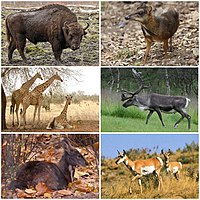
Photo from wikipedia
Ruminants differ in the degree of rumen content stratification, with 'cattle-types' (i.e., the grazing and intermediate feeding ruminants) having stratified content, whereas 'moose-types' (i.e., the browsing ruminants) have unstratified content.… Click to show full abstract
Ruminants differ in the degree of rumen content stratification, with 'cattle-types' (i.e., the grazing and intermediate feeding ruminants) having stratified content, whereas 'moose-types' (i.e., the browsing ruminants) have unstratified content. The feeding ecology, as well as the digestive morphophysiology of the giraffe (Giraffa camelopardalis), suggest that it is a 'moose-type' ruminant. Correspondingly, the giraffe should have an unstratified rumen content and an even rumen papillation pattern. Digesta samples were collected from along the digestive tract of 27 wild-caught giraffes kept in bomas for up to 2months, and 10 giraffes kept in zoological gardens throughout their lives. Samples were analysed for concentration of dry matter, fibre fractions, volatile fatty acids and NH3, as well as mean particle size and pH. There was no difference between the dorsal and ventral rumen region in any of these parameters, indicating homogenous rumen content in the giraffes. In addition to the digesta samples, samples of dorsal rumen, ventral rumen and atrium ruminis mucosa were collected and the papillary surface enlargement factor was determined, as a proxy for content stratification. The even rumen papillation pattern observed also supported the concept of an unstratified rumen content in giraffes. Zoo giraffes had a slightly more uneven papillation pattern than boma giraffes. This finding could not be matched by differences in physical characteristics of the rumen content, probably due to an influence of fasting time ante mortem on these parameters.
Journal Title: Comparative biochemistry and physiology. Part A, Molecular & integrative physiology
Year Published: 2017
Link to full text (if available)
Share on Social Media: Sign Up to like & get
recommendations!